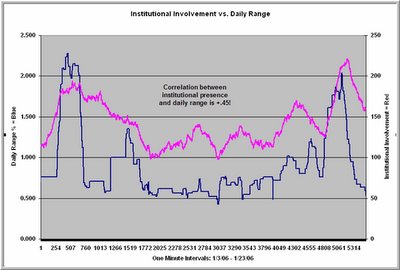
I couldn't wait to add this to the blog. Check my personal site tomorrow for details. This is a measure of institutional presence in the market that updates every 20 seconds. It correlates with daily price range by .45 since the beginning of January. Now the question is whether institutional involvement during period X will predict volatility in period Y. Stay tuned...this is getting fun.
I have received a number of email inquiries regarding indicators for assessing the likely volatility of the coming day's trade. I will post something to my personal site shortly on this topic. Obviously such information is invaluable on days such as Monday, when all indications from Friday pointed to likely volatility. When we saw the narrow overnight range, however, followed by mediocre volume in the ES, it became clear that this was not going to be a breakout day. Being able to evaluate volatility in real time is critical, because it enables you to handicap the odds of moves breaking through ranges vs. reversing back into the ranges. As we can see from the comparison of Friday and Monday, greater volume and volatility makes the difference between a day of breakouts and a range bound day.
We followed Friday's large decline with a small gain amidst low volatility on Monday. As we saw from the previous posts, this is a statistically unusual event. When I went back to December, 1998 (N = 1793), I found how unusual this is. After a large decline of more than 1.5%, we have never--until Monday--had a rise on such low volatility. For what it's worth, small bounces from large declines that occurred on ranges of less than 1.5% (N = 8) were down the next day on six of those occasions for an average loss of -.94%. In general, lower volatility bounces tended to fare more poorly three days out than high volatility rises. While the numbers are too small for statistical significance, their bearish cast makes sense given that--thus far--the downside is attracting more interest than the upside and--in Market Profile terms--we are accepting value at progressively lower prices.




